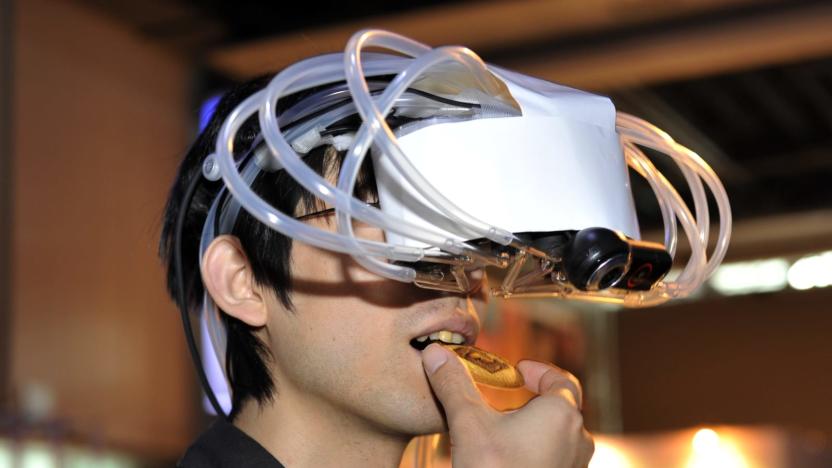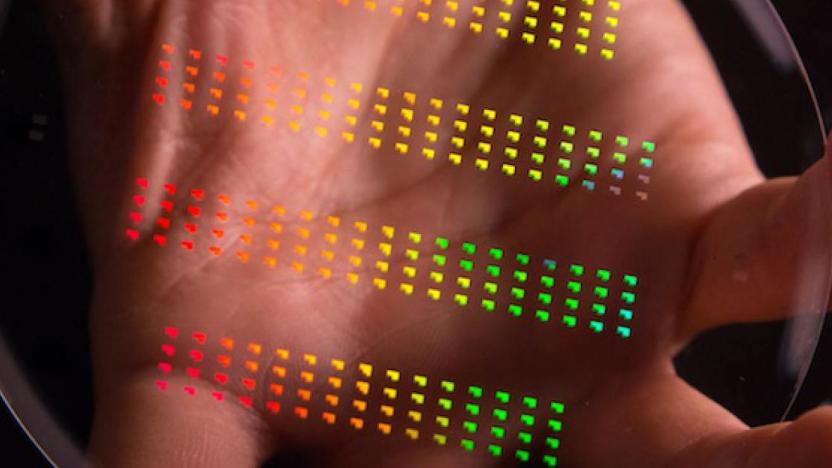Stanford uNIVERSITY
Latest

Smellable VR is coming whether you want it or not
Modern virtual reality is a treat for the senses. Well, two of them at least. "Sight and sound have been the staple of VR environments," Benjy Li, a postdoctoral researcher with Stanford's Virtual Human Interaction Lab, told Engadget. Haptic feedback is starting to allow for basic touch, but the next radical evolution in VR could actually come via your nose (and/or mouth).

Stanford’s ‘accelerator on a chip’ could revolutionize medical care
When the SLAC National Accelerator Laboratory at Stanford first opened its doors in 1966, it had already earned the distinction of housing the world's longest linear accelerator: A 3.2 kilometer monstrosity buried 25 feet under the gently rolling hills of Northern California. Today the lab, along with an international consortium of research organizations, is working to create a new kind of accelerator -- one small enough to fit in a shoebox but offering huge scientific potential.

Why buy the cow when you can biofabricate the milk for free?
Thought to have been Lord Krishna's favorite animal, the cow has achieved a uniquely sacred status in India. Their slaughter is prohibited through most of the country, beef consumption is largely outlawed as well and woe be the unlucky soul accused of breaking those taboos. In the US, however, that's not the case. We Americans love our cows. We love them so much that we ate a whopping 25.668 billion pounds of beef in 2016, according to the National Cattlemen's Beef Association. There are 93.5 million heads of cattle in this country, but thanks to emerging biofabrication technologies, they could soon be as safe from the slaughterhouse as the cows of Delhi.

Plastic-plucking robots are the future of recycling
We are living in the Age of Plastic. In 2015, the world's industries created 448 million tons of it -- twice as much as it did in 1998 -- and the rate of production is only accelerating. However, our recycling efforts have not matched pace. In fact, according to the EPA, barely 14 percent of plastic products are recycled globally. But a new generation of recycling technology is here to keep the world's plastics in circulation and out of our landfills.

ICYMI: Submersible sticky situations and elongating elastomer electrodes
Today on In Case You Missed It: Researchers from Purdue University and the Office of Naval Research teamed up to develop a new kind of glue that even works underwater. The synthetic compound is derived from proteins used by muscles to keep themselves attached to rocks. The man-made adhesive is 17 times stronger than its source material and could one day hold US Navy ships together. We also take a look at a stretchable electrode developed at Stanford University. Leveraging the same kind of molecule that commercial kitchens use to thicken soups, the Stanford researchers were able to develop an electrical conductor that can be easily deformed while actually conducting better as it is stretched. And finally, this is what happens when you hook a watermelon up to a car battery. As always, please share any interesting tech or science videos you find by using the #ICYMI hashtag on Twitter for @mskerryd.

Stanford has developed a roadside breathalyzer for weed
Blood, breath and urine. These are the holy trinity of determining alcohol intoxication but are virtually useless when measuring the amount of THC in your system thanks the molecule's ability to remain present in bodily fluids for up to a month after consumption. However, a technological breakthrough from Stanford University could soon enable law enforcement to accurately determine how blunted you are as soon as they pull you over.

The Eye-Sync system can diagnose concussions in one minute
Concussions are no joke -- just ask Cam Newton -- but a new diagnostic system developed in conjunction with Stanford University could revolutionize the way these head injuries are determined. The Eye-Sync, from the SyncThink company, uses a modified VR headset and custom software running on a consumer tablet to diagnose concussions in just one minute.

Stanford researchers 'cool' sunlight to improve solar cell efficiency
A team of researchers from Stanford University have devised an ingenious means of boosting the efficiency of solar panels by exploiting a fundamental physics phenomenon. Solar panels lose efficiency as they heat up. Just as the top of your head radiates excess body heat as infrared light, the researchers have developed a translucent overlay comprised of patterned silica that does the same for solar panels. The overlay separates the visible spectrum of light (which generates electricity) from its thermal radiation (aka heat), effectively "cooling" the incoming light, radiating the heat away from the panel while allowing more photons to be converted into electricity. The team, led by Stanford professor Shanhui Fan, recently published their findings in the journal, Proceedings of the National Academy of Sciences.

Dallas Cowboys become the first NFL team to go all-in on VR
When an old-school coach like Mike "Da Bears" Ditka gets behind virtual reality as a football training device, you know there's something there. And now, the Dallas Cowboys are the first NFL team to adopt VR tech from a Stanford-based company called StriVR Labs, according to ESPN. The franchise dedicated a new room at its training facility to the tech, which it'll use to help quarterbacks, linebackers and safeties. Players will put on an Oculus Rift or other headset and then watch scrimmages recorded by 360-degree cameras attached to players' helmets.

How cheap VR helped a Stanford professor bring his dream to Tribeca
Last year, the Tribeca Film Festival began highlighting new mediums being used in storytelling, and that trend has translated over to 2015. Virtual reality is, naturally, a big part of this movement, as filmmakers start creating more content for consumer-grade devices like the Oculus Rift, Samsung Gear VR and Google Cardboard. This is why the current edition of the event is hosting Stanford's Virtual Human Virtual Interaction Lab, a venture started in 2003 by Jeremy Bailenson, who's a professor at the university and has been working on digital human representation since 1999. It features a set of VR experiences that attendees can check out, all with the same goal of transporting you into another reality.

Stanford scientists make leukemia 'grow up' and eat itself
A team at Stanford's School of Medicine has reportedly uncovered a potent new treatment method for combating one of leukemia's most aggressive forms -- and they did it pretty much by accident. While survival rates for B-cell acute lymphoblastic leukemia, a particularly nasty form of white blood cell cancer, have risen to about 85 percent over the past decade thanks to the advent of stem cell therapies, the prognosis for this disease in the presence of a Philadelphia chromosome mutation remains quite poor. But thanks to a chance observation by Dr. Scott McClellan, the Stanford team believes it's figured out way to neutralize the disease using its own cancerous cells against it.

Researchers can profile Facebook users to a 'T' with just their likes
Remember the time you liked a beer pong video on Facebook and thought nothing more of it? That may have said more about you than your friends and family ever knew, according to researchers at Cambridge and Stanford. They created a computer program that sifted through the Facebook likes of over 85,000 users to see if a person's preferences could rat out their true persona. The team used certain associations that seem fairly obvious; for instance, liking tattoos means you're more likely to drink alcohol. Others were more bizarre: apparently, people who like curly fries tend to be intelligent. Who knew?

Stanford University makes its own Gecko-inspired wall climbing pads
Military types are obsessed with the Gecko because of the unique structure of its feet, which enable it to climb walls like Spider-man. Earlier this year, DARPA told the world that one of its labs had built a pair of pads that would enable a 218-pound person wearing 50 pounds of gear to pretend that they're Tobey Maguire. Of course, the method for building the pads was a closely guarded secret, but a team at Stanford University believes that it's cracked the formula. In essence (really paraphrasing here), the group started with PDMS -- polydimethylsiloxane -- a composite more commonly found in water-repellant coatings, skin moisturizers and at least one franchise burger joint's chicken nuggets. The substance was then molded into microwedges to increase the surface area, and crammed into a hexagonal plate with a handle. Testing is still underway, and as you can see in the video below, it's not the most exciting thing to see -- but we figure that millions of teenagers are currently adding this to their gift lists in the hope of making it easier to sneak in and out on a Friday night.

Hackers transform a smartphone gyroscope into an always-on microphone
Apps that use your smartphone's microphone need to ask permission, but the motion sensors? No say-so needed. That might not sound like a big deal, but security researchers from Stanford University and defense firm Rafael have discovered a way to turn Android phone gyroscopes into crude microphones. They call their app "Gyrophone" and here's how it works: the tiny gyros in your phone that measure orientation do so using vibrating pressure plates. As it turns out, they can also pick up air vibrations from sounds, and many Android devices can do it in the 80 to 250 hertz range -- exactly the frequency of a human voice.

Scientists make deep-brain implants possible through wireless charging
Stanford researchers have figured out a way to wirelessly charge electronic devices that are deep inside your body. Currently pacemakers and nerve transmitters need to have large receiving coils near the top of your skin to charge up (limiting where you can put them), or periodically have their battery replaced through surgery. This new method, however, would allow devices to be much smaller because they don't have to tote around such a huge battery. Also since they're not reliant on charging coils they could live much deeper in the body and brain.

Art Levinson discusses the post-Jobs era
Art Levinson summed up his experience as chairman of Apple's board of directors since Steve Jobs passed in one word. "Weird," said Levinson who spoke on Tuesday at Stanford's Graduate School of Business "I'm still not to the point where I walk into that boardroom and don't miss Steve," Levinson added. According to a report in Fortune, Levinson talked about a wide range of topics covering his relationship with Jobs, his role as the chairman of Apple's board and his management style at Genentech. Though there are changes at Apple under Tim Cook, Levinson is optimistic about the company in the long run. "There [are] long-term signs of how a company is doing and whether or not Apple sells 47 or 48 million iPhones -- let somebody else worry about that," he said. You can read more about Levinson's talk in the article on Fortune and view people's reactions on Twitter. [Image from Sten Tamkivi]

Stanford researchers create 'world's first' all-carbon solar cell, do it on the cheap
Harnessing the awesome power of the Sun isn't just dependent on the efficiency of solar cells, but also on making them affordable. Current techniques aren't exactly cheap, but researchers from Stanford University think they've made a bit of a breakthrough by producing a relatively inexpensive photovoltaic cell using nothing but carbon. We're sure other scientists might disagree with the 'world's first' claim, but those at Stanford think it's a matter of language, and that these other pretenders are "referring to just the active layer in the middle, not the electrodes." The team selected a trio of carbon types to use in their cell: a mixture of nanotubes and buckyballs make up the light-absorbing layer, while graphene is being utilized for the electrodes. The carbon amalgam can be applied from solution using simple methods, meaning the flexible cells could be used to coat surfaces, although you won't be seeing it smeared over anything too soon. The prototype only touts a "laboratory efficiency of less than 1 percent," so it can't compete with traditional solar cells just yet. Also, it only absorbs a sliver of the light spectrum, but the researchers are looking to other forms of the wonder element which could increase that range. They are hoping that improving the structure of the cells will help to boost their efficiency, too. They might never generate the most energy, but the all-carbon cells can remain stable under extreme conditions, meaning they could find their calling in harsh environments where brawn is a little more important than status, or looks.

Folding@Home packs up on PlayStation 3: over 100 million computation hours added to research
Squared away in the PlayStation 3's latest software update post, Sony announced that the Folding@Home service will be retired starting next month, alongside the console's 4.30 update. The project, which tied into Stanford University's work on protein folding and research into the causes of a diseases like Alzheimer's, pulled in over 15 million PlayStation owners since it started in 2007. In fact, according to Stanford's client statistics, PS3 users offered the second greatest contribution after Windows devices, adding more than 100 million computation hours to the research project -- and well, we did our bit.

Google releases Course Builder, takes online learning down an open-source road
Google is well-known for projects with unexpected origins. It's almost natural, then, that the code Google used to build a web course has led to a full-fledged tool for online education. The open-source Course Builder project lets anyone make their own learning resources, complete with scheduled activities and lessons, if they've got some skill with HTML and JavaScript. There's also an avenue for live teaching or office hours: the obligatory Google+ tie-in lets educators announce Hangouts on Air sessions. Code is available immediately, although you won't need to be grading virtual papers to see the benefit. A handful of schools that include Stanford, UC San Diego and Indiana University are at least exploring the use of Course Builder in their own initiatives, which could lead to more elegant internet learning -- if also fewer excuses for slacking.

Autonomous Wave Glider bot launched to track sharks, beam real-time data to your iPhone and iPad
When they're not breaking world records, fuel-hating Wave Glider seabots like to indulge in other hobbies, like shark tracking. One of the vessels has just been launched off the coast near San Francisco (vid after the break), adding a mobile worker to the existing local network of buoy-mounted receivers. They monitor the movements of electronically tagged sea life, including the fearsome Great White, picking up signals within a 1,000-foot range while researchers from Stanford University analyze the data from the safety of the shore. Better still, the free Shark Net iOS app gives anyone the chance to track these things, and activity should increase as the monitoring network (hopefully) expands along the west coast and more bots are introduced. You didn't think the world's fascination sharks was limited to only a single single week, did you?








